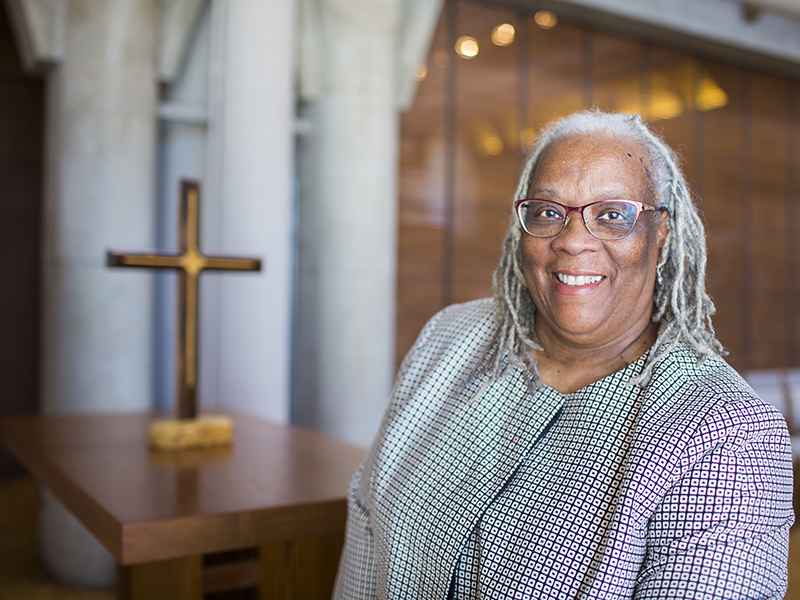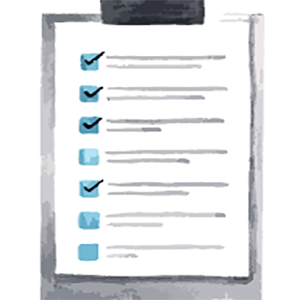Determinant Determination
Disparities in the distribution of wealth, power, and resources shape the conditions into which we are born, live, work, and play—often driving adverse health outcomes and risks.

Thanks to professor Jill Hamilton and her peers, understanding these social determinants and how they impact patients have become an integral part of the School of Nursing’s curriculum.
Jill Hamilton has never been one to turn down an opportunity to transform how nursing students and nurses care for patients.
So when Dean Linda McCauley asked the associate professor to lead an initiative to integrate the social determinants of health (SDOH) into each and every class at the Nell Hodgson Woodruff School of Nursing, Hamilton said yes. She well knew the importance of the task at hand. For a number of years, the World Health Organization (WHO), the Centers for Disease Control and Prevention (CDC), the Association of American Colleges of Nursing (AACN), and other agencies have called for addressing the SDOH to reduce health inequities among minority, ethnic, LGBTQ, and rural populations. Hamilton’s own research has centered on health disparities among African Americans, including the social determinants that influence coping with a cancer diagnosis.
When talking with students and faculty about the SDOH, Hamilton points to a definition from the US Department of Health and Human Services report Healthy People 2030. It describes social determinants as “conditions in the environments in which people are born, live, work, play, worship, and age that affect a wide range of health, functioning, and quality of life outcomes and risks.”
Hamilton witnessed these conditions long before “social determinants of health” became part of health nomenclature. She grew up in a small, rural African American community in western North Carolina, where she first practiced nursing in 1982.
“Everyone knew then that people of color didn’t get the same quality of care,” she remembers. “When I was in nursing school [at the University of North Carolina at Chapel Hill], the thinking was that if we educated more health professionals who are members of those populations, it would help alleviate the problem. We also needed to place more of them in rural settings. Both helped address the problem to some extent. But in spite of these efforts, we still have health disparities among people of color and in rural areas.”
Hamilton has a vision for how to do better. “It’s not about certain populations trying to alleviate the problem,” she says. “It’s up to each and every one of us in the nursing profession to alleviate health disparities. People are suffering and dying because we haven’t figured out how to address the social determinants of health.”
The place to begin, AACN and Emory leaders agree, is in the nursing curriculum. “We want to move away from a place where the social determinants of health are taught in certain courses and not in others,” Hamilton says. “We know that’s important because our nursing accreditation boards have said so. Above all, it’s important that we fully embrace it, so that we provide the best care to our patient populations.”
Jill Hamilton
Associate Clinical Professor Hope Bussenius 93MSN has included the SDOH in her courses for years. At the start of the health assessment course she coordinates, undergraduate students complete a self-evaluation to gauge their cultural awareness and their ability to assess different communities and populations.
“It leads to some powerful conversations with students,” says Bussenius, who has served vulnerable populations in Atlanta, Haiti, and North Carolina, where she grew up in the Lumbee Tribe. “It’s important that they learn how to gather subjective components from different populations of patients—their family history, their symptoms, their chief complaint—and how those components are threaded through their health history. We orient students early on to conduct those interviews through a cultural evaluation lens.”
Culture is part of the curricular framework Hamilton developed for the School of Nursing. The framework rests on four SDOH pillars: social, cultural, environmental, and policy. She considered other frameworks used in medicine and public health, but they gave her pause.
“I’m not saying those frameworks are wrong,” says Hamilton. “But it was clear to me that nursing needed something more pragmatic and comprehensive—something that could guide us in the way we approach social determinants among the diverse populations that we serve. Nurses are in hospitals, in clinics, in communities, in schools. We needed a framework that’s useful, regardless of the setting or population.”
WOVEN INTO THE CURRICULUM
Faculty are rolling out the SDOH in phases. In fall 2020, they wove them into their course objectives for students in the MN+MSN program. This spring, students in the InEmory program began learning about them, followed by students entering the Distance Accelerated BSN program this summer. This fall, the SDOH will span the entire curriculum, including courses for DNP and PhD students.
“We know this is a huge undertaking, and it’s a lot to ask faculty to incorporate these concepts into their objectives and their teaching strategies,” says Hamilton. “We are going to emphasize one pillar each semester, so that faculty and students don’t feel overwhelmed.” "It’s up to each and every one of us in the nursing profession to alleviate health disparities. People are suffering and dying because we haven’t figured out how to address the social determinants of health."
DNP student Priya Schaffner 18N 19MSN is helping Hamilton’s faculty team bring the SDOH to life across the curriculum. Schaffner remembers how it used to be as an Emory BSN and MSN student only a couple of years ago.
“Generally, the exposure to the SDOH was in course readings or a PowerPoint slide,” she says. “It was introduced, but it didn’t go the next step into how these determinants play a role in health. Dr. Hamilton wants to push students to think, ‘how can I address them?’”
Schaffner is reviewing course assignments with an eye toward incorporating SDOH concepts in meaningful ways. For one course, she has recommended turning a conflict outcome journal assignment into an SDOH clinical reflection.
“For example, if transportation is an issue for a patient and poses a conflict in making an appointment, what are some community resources that could address this determinant of health,” says Schaffner. “That’s the next step—what can I as a student do to address the problem?”
She came to that very realization as a student in the family nurse practitioner program. She was completing a clinical rotation at Mercy Care, which serves homeless and other vulnerable patients in Atlanta. “It was the first clinical setting where the work I was doing was interwoven with the work being done to address the social determinants of health. Everything—social work, behavioral health, primary care—was done simultaneously as a team.”
“As nurses—depending on what setting you’re in—we have the means, the skills, the leverage to make important changes in patients’ lives,” Schaffner adds. “The model is patient-centered care, which is very much at the heart of the nursing model. It all really hit home for me at Mercy Care.”
SHIFT IN PERCEPTION
Once the curriculum changes at the School of Nursing firmly take hold, Hamilton expects to see a shift in how faculty and students perceive the SDOH. Rather than seeing them as detriments to health, could some be seen as strengths? Are there specific determinants that can improve a patient’s health?
In her studies of how African Americans cope with cancer, Hamilton has observed how the cultural factors of spirituality and religious songs help ease their depression and anxiety. Those studies inform her discussions with students about the African American population, which continues to have the highest rates of cancer illness and deaths. She encourages students to consider how to address the SDOH that contribute to these morbidity and mortality rates. Does the patient have social support at church or in the community? What are their spiritual beliefs? Does their home and family environment increase or alleviate their stress? Are there policies at their hospital, doctor’s office, or in the community that contribute to their anxiety?
By raising similar questions throughout the nursing curriculum, faculty will broaden and deepen how students care for patients and populations as nurses.
“Students will begin to think more about the factors that contribute to a patient’s illness and recovery,” says Hamilton. “It’s never one thing that causes a patient to become ill. It’s multiple factors. The social determinants of health are not independent of each other. They are tied together like a piece of woven cloth.”
Bussenius has taken Hamilton’s initiative to heart by focusing more on the application of the SDOH in her teaching. Recently, she helped run a health equity simulation that Assistant Clinical Professor Quyen Phan developed for undergraduate students in her population health course. During the simulation, students play different roles in a scenario that illustrates the difficulties a hospital patient and family encounter in navigating a bewildering health care system. The scenario is based on the courses Bussenius and Phan have taught for years.
“It’s going to take all of us to continue moving forward,” says Bussenius. “We now have a structure for defining the social determinants of health that gives it more meat and potatoes, I would say. Now we can move forward and all be on the same page.”
School of Nursing students are leveraging Project NeLL to incorporate health disparities research into their capstone and dissertation projects.
The School of Nursing’s Alexis Dunn Amore is building a web platform and mining Big Data to help mothers—especially Black mothers—and their infants survive childbirth.
A Powerful Research Tool

Reducing Risks of Maternal Mortality

Photography Disclaimer: COVID-19 protocols appropriate to each setting and time were followed in taking the photographs that appear in this magazine.






